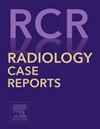1例6岁儿童hache消失白质综合征伴疱疹性脑炎的不典型初始表现:病例报告及简要回顾
Q4 Medicine
引用次数: 0
摘要
白质消失综合征(WMS)是最常见的遗传性白质脑病之一,影响所有年龄段,包括新生儿和成人。我们报告一例6岁儿童因突然意识丧失而被急诊科收治,根据最近的疱疹病毒感染怀疑为疱疹性脑炎,其脑部MRI显示白质消失,随后通过鉴定EIF2B5基因突变证实。消失的白质(VWM)综合征,也被称为婴儿共济失调伴中枢性髓鞘退化,是一种主要影响中枢神经系统白质的罕见遗传性疾病之一,由c突变引起。这种损伤通常影响大脑深部区域,不包括u形纤维,这一发现对区分其他原因的白质营养不良有很大的诊断价值。由于MRI方面与EIF2B1-5基因突变之间有很好的相关性,因此MRI是一种基础诊断测试,对建立诊断具有很好的敏感性。Guanabenz和Fosigotifatorsont是两种有希望改善该人群生活质量和预后的分子。本文章由计算机程序翻译,如有差异,请以英文原文为准。
An atypical initial revelation of CACH-vanishing white matter syndrome miming herpetic encephalitis in a 6-year-old child: Case report and brief review
White matter vanishing syndrome (WMS) is one of the most common hereditary leukoencephalopathies, affecting all ages, including newborns and adults. We report the case of a 6-year-old child admitted to the emergency department with sudden loss of consciousness, in whom herpetic encephalitis was suspected on the basis of recent herpes virus infection, and whose brain MRI showed Vanishing White Matter, subsequently confirmed by identification of the EIF2B5 gene mutation. Vanishing White Matter (VWM) syndrome, also known as infantile ataxia with central hypomyelination, is a leukodystrophy which is one of a wide range of rare genetic disorders primarily affecting the white matter of the central nervous system, caused by mutations in the c. This damage generally affects the deep areas of the brain, and does not spare the U-shaped fibers, a finding of great diagnostic interest for differentiating from other causes of leukodystrophies. MRI is a fundamental diagnostic test with good sensitivity for establishing the diagnosis because of a very good correlation between MRI aspects and mutations in the EIF2B1-5 genes. Guanabenz and Fosigotifatorsont represent 2 promising molecules for improving quality of life and prognosis in this population.
求助全文
通过发布文献求助,成功后即可免费获取论文全文。
去求助
来源期刊

Radiology Case Reports
Medicine-Radiology, Nuclear Medicine and Imaging
CiteScore
1.10
自引率
0.00%
发文量
1074
审稿时长
30 days
期刊介绍:
The content of this journal is exclusively case reports that feature diagnostic imaging. Categories in which case reports can be placed include the musculoskeletal system, spine, central nervous system, head and neck, cardiovascular, chest, gastrointestinal, genitourinary, multisystem, pediatric, emergency, women''s imaging, oncologic, normal variants, medical devices, foreign bodies, interventional radiology, nuclear medicine, molecular imaging, ultrasonography, imaging artifacts, forensic, anthropological, and medical-legal. Articles must be well-documented and include a review of the appropriate literature.
 求助内容:
求助内容: 应助结果提醒方式:
应助结果提醒方式:


